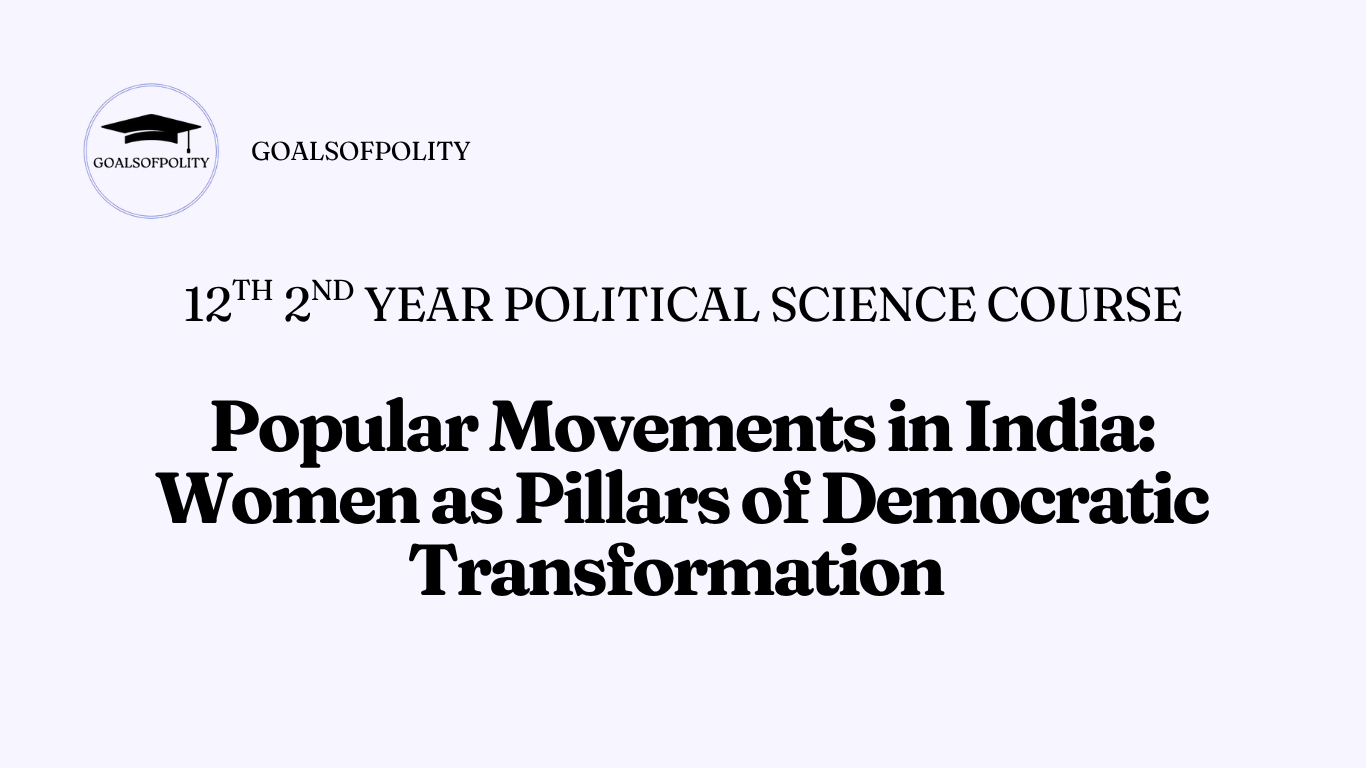Table of Contents:
India’s democratic journey has been deeply influenced not just by elections, institutions, and constitutional debates but also by the vibrant spirit of popular movements. At the heart of many of these movements are women, who have emerged not just as participants but also as leaders, voices of conscience, and catalysts of democratic change.
Historically and in contemporary times, Indian women have taken to the streets, forests, and fields to demand justice, equality, and inclusion. From grassroots struggles to nationwide protests, they have shaped India’s democratic character in transformative ways.
Discover eight powerful popular movements in India where women were at the forefront, redefining the meaning and practice of democracy.
The Beginning: Pre-Independence Era:
In India, the fight for women’s rights began during the colonial period in the 19th century. Women’s rights were established by reformers like Raja Ram Mohan Roy and Ishwar Chandra Vidyasagar, who fought against traditions like child marriage and sati. The formation of organizations such as the Bharat Stree Mahamandal by Sarala Devi Chaudhurani in 1910 was one of the first collective efforts to address women’s issues at the national level.
All India Women’s Conference (AIWC):
ounded in 1927, the AIWC became an important organization in the fight for women’s rights. It played a key role in advocating for women’s education, social reforms, and political participation. The AIWC played a key role in ensuring a more significant role for women in the political sphere, contributing to the inclusion of gender equality in the Indian Constitution.
1. Chipko Movement:
Founded in the 1970s in the Uttarakhand region, the Chipko Movement is one of India’s most well-known environmental movements. Led by rural women, the movement aimed to protect forests from commercial logging. Recognizing the important role of forests in their daily lives, the women embraced trees to prevent them from being cut down. Global attention was drawn to this act of nonviolent resistance, which raised awareness of environmental problems in India and eventually influenced conservation and forestry legislation.
2. Narmada Bachao Andolan (Save the Narmada Movement):
The Narmada Bachao Andolan (NBA) began in the 1980s, protesting the construction of large dams on the Narmada River, which threatened to displace thousands of people, primarily indigenous communities. Women were at the forefront of this movement, advocating for sustainable development and the rights of displaced persons. Their persistent efforts drew international attention to the human and environmental costs of large-scale development projects, challenging the narrative of unchecked industrial progress.

3. Anti-dowry movement:
The anti-dowry movement emerged in response to the widespread practice of dowry, which often led to violence against women, including dowry deaths. The movement saw significant participation of women’s organizations and activists, who campaigned for the enactment of the Dowry Prohibition Act (1961). The efforts of the movement led to stricter laws and increased social awareness, although the fight against dowry continues to this day.
4. Prohibition Movement:
Anti-alcohol movement in Andhra Pradesh:
The anti-alcohol movement in Andhra Pradesh, led by rural women in the 1990s, focused on banning the sale of alcohol in the state. Alcohol addiction was seen as a major cause of domestic violence and financial ruin in families. Women staged protests and formed human chains to demand prohibition. Their successful movement led to a temporary ban on the sale of alcohol, demonstrating the power of collective action in bringing about policy change.
5. Movement against Khap Panchayat:
Khap panchayats, traditional village councils in North India, often uphold regressive and patriarchal norms. Women activists have been vocal in opposing khap panchayat decisions, especially those related to honor killings and forced marriages. These movements have drawn national attention to the need for legal reforms and protection of women’s rights against archaic practices.
6. Gulabi Gang:
A vigilante organization of women activists, the Gulabi Gang was established in Uttar Pradesh by Sampat Pal Devi to combat social injustices such as child marriage and domestic abuse. Dressed in pink saris, the Gulabi Gang uses direct action to challenge gender-based violence and corruption. Their unconventional methods have sparked debate over the effectiveness and ethics of vigilantism but have undeniably highlighted persistent issues of gender-based violence and inequality.
7. Protest against AFSPA in Manipur:
In Northeast India, particularly in Manipur, the Armed Forces (Special Powers) Act (AFSPA) has generated controversy. Women activists, including the iconic Irom Sharmila, have long protested against the AFSPA, demanding its repeal due to alleged human rights abuses by the army. In 2004, a group of Manipuri women staged a nude protest holding banners that read “Indian Army rapes us”, which shocked the entire country and drew international attention to their cause. These movements underscore the intersection of gender, militarization, and human rights.
8. Nirbhaya Movement:
After a young woman in Delhi was brutally raped and killed by a gang in 2012, the Nirbhaya campaign was born. Young women and students were the main leaders of the nationwide rallies that followed the tragedy, calling for stricter legislation and safer public areas for women. The movement resulted in significant legal reforms, including amendments to rape laws and the establishment of fast-track courts for sexual assault cases. The Nirbhaya movement is an example of how public outrage and sustained activism can inspire legislative change and transform societal attitudes toward gender violence.
Conclusion:
These movements reflect the profound impact of women’s activism on India’s democratic fabric. By addressing issues ranging from environmental protection to gender violence, these movements have not only advocated for specific causes but also contributed to the broader struggle for justice, equality, and democratic governance. As India continues to develop, the legacy of these movements underscores the important role women play in shaping a more inclusive and equitable society.
FAQs: Popular Movements in India – Women as Pillars of Democratic Transformation
1. Why is the role of women important in popular movements in India?
Answer: Women contribute distinct viewpoints derived from personal experience. Their participation ensures that movements are inclusive, community-driven, and often more peaceful and sustainable. They challenge both social injustice and patriarchal power structures.
2. Which female-led movement in India is regarded as the forerunner of environmental activism?
Answer: The Chipko movement in the 1970s, led by women like Gaura Devi, is considered one of India’s first large-scale environmental protests.
3. What impact did the Shaheen Bagh protest have on Indian democracy?
Answer: It revived public debate on constitutional values like secularism and citizenship and demonstrated the power of non-violent civil resistance led by women.
4. How did women contribute to the Nirbhaya movement?
Answer: Women, especially youth and students, led protests demanding justice and legal reform. Their advocacy led to the enactment of the Criminal Law (Amendment) Act of 2013.
5. Are women’s movements only about gender issues?
Answer: No. While gender justice is important, women have also played a key role in broader democratic processes by spearheading campaigns for environmental protection, land rights, health, education, and anti-corruption.
6. What democratic values were promoted by these women-led movements?
Answer: Equality, justice, participation, accountability, decentralization, and non-violence.

